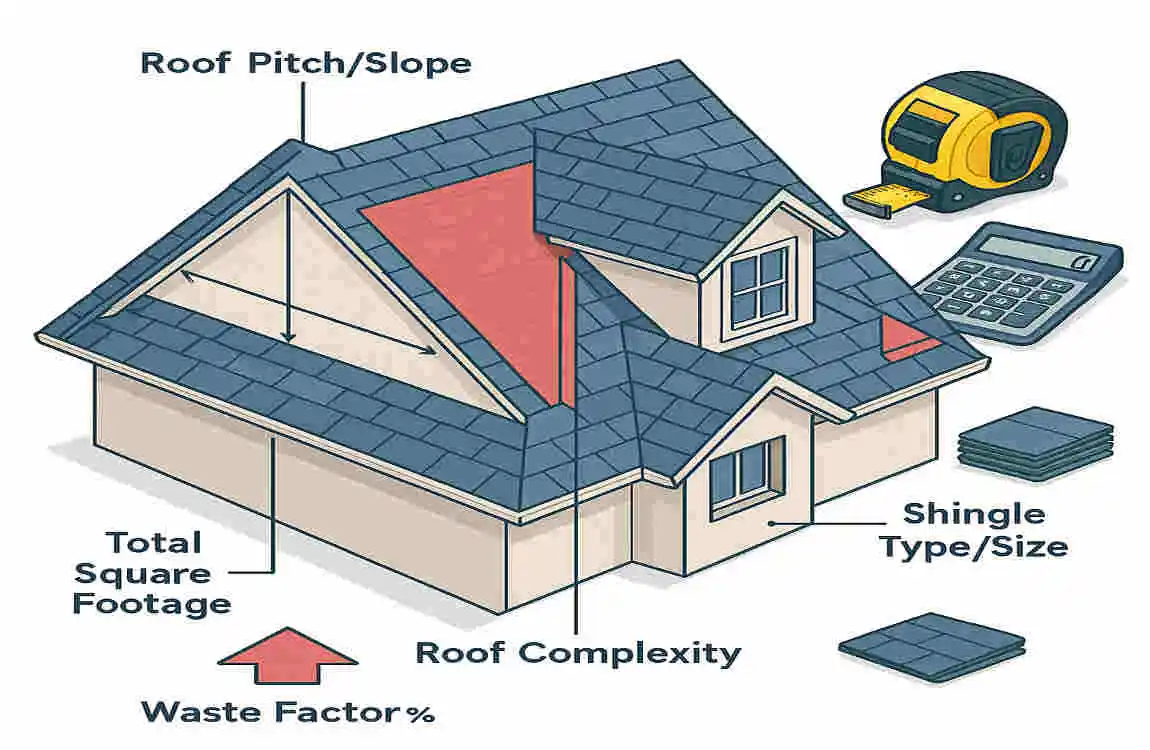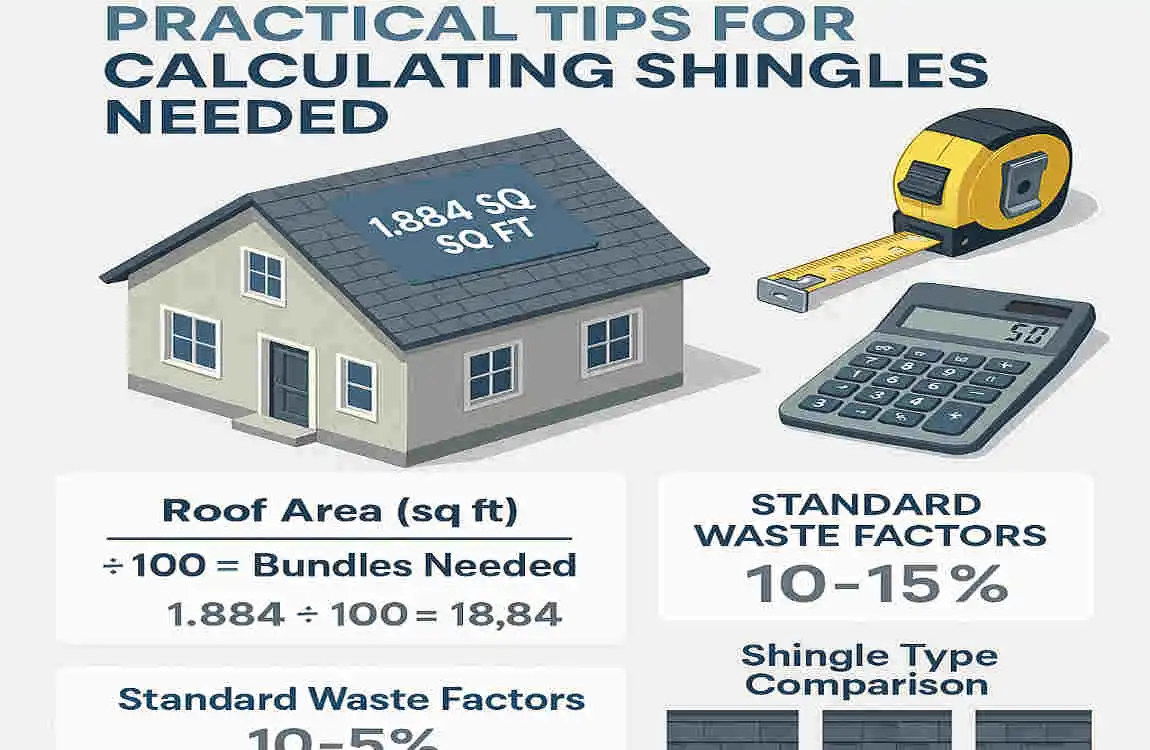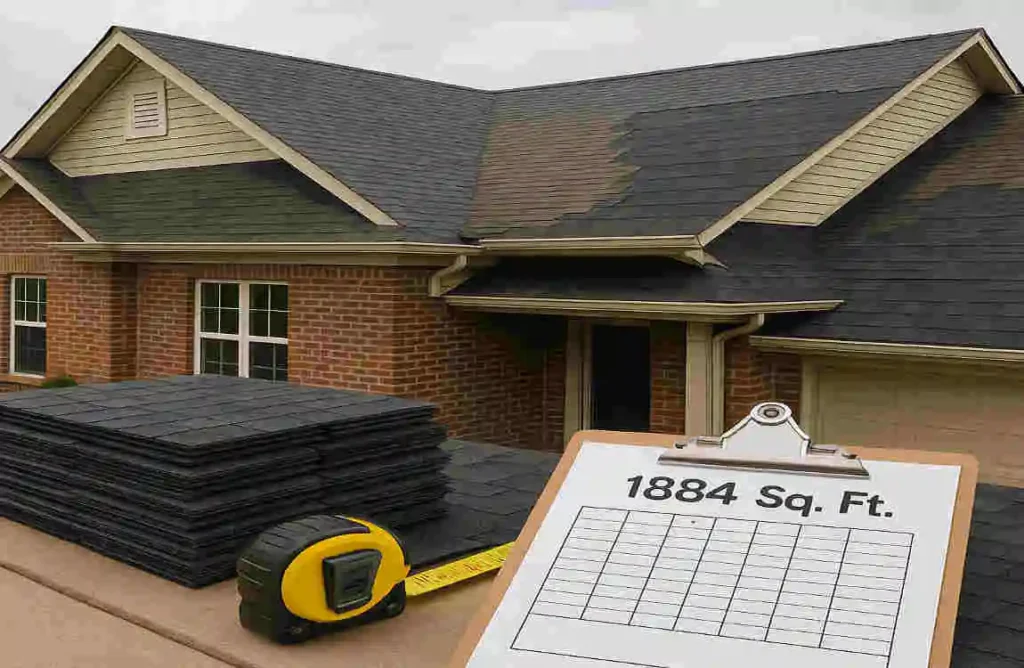When it comes to roofing projects, one of the most common questions homeowners ask is, “How many shingles do I need?” If you’re planning to re-shingle your 1884 sq ft roof, you’re in the right place.
Why Accurate Shingle Estimation Matters

Before we dive into the nitty-gritty of shingle calculations, let’s talk about why getting this right is so important.
Saving Money and Avoiding Delays
Accurate material counts are crucial for any roofing project. When you know precisely how many shingles you need, you can avoid overbuying and wasting money on excess materials. On the flip side, underestimating your shingle needs can delay your project as you wait for additional materials to arrive.
Accounting for Waste and Adjustments
Even with the best planning, some waste is inevitable during a roofing project. Waste allowances help account for cutting shingles to fit around rafters, vents, chimneys, and ridge caps. They also cover any on-site adjustments you might need to make. By factoring in a reasonable waste allowance, you can ensure you have enough shingles to complete your project without running short.
Key Factors That Affect Shingle Needs
Now that we understand why accurate estimation is essential, let’s explore the key factors that influence how many shingles you’ll need for your 1884 sq ft roof.
Roof Area vs. Roof “Squares”
The first step in calculating shingle needs is to convert your roof’s area into “squares.” One square equals 100 sq ft. For an 1884 sq ft roof, you’ll have about 18.84 squares.
Shingles are typically sold in bundles, each covering approximately 33 sq ft (0.33 squares). To find your baseline shingle count, multiply the number of squares by the number of bundles per square. For an 1884 sq ft roof, this comes out to:
18.84 squares × 3 bundles per square ≈ 56.5 bundles
Rounding up, you’ll need about 57 bundles, excluding waste.
Roof Pitch/Steepness
The pitch or steepness of your roof can significantly impact the number of shingles required. Steeper roofs have a reduced effective area per bundle, meaning you’ll need more bundles to cover the same roof area. Depending on the pitch, you might need 5-15% more material or even more if the roof requires extensive cuts.
Roof Shape and Features
The shape of your roof and any unique features can also affect your shingle needs. Complex roofs with valleys, dormers, hips, or large penetrations tend to generate more waste. In these cases, you should plan for a higher waste allowance to ensure you have enough shingles to complete the job.
Shingle Type and Bundle Size
Lastly, the type of shingles you choose and the bundle size can impact your calculations. Traditional asphalt shingles typically come in bundles of three per square, with each bundle containing around 29-33 shingles. However, it’s essential to verify the bundle size for the specific product you’re using to ensure accurate calculations.
Quick Calculation Method: A Step-by-Step Guide
Now that we’ve covered the key factors, let’s walk through a quick calculation method to estimate the number of shingles needed for your 1884 sq ft roof.
Convert Roof Area to Squares
To start, convert your roof’s total area to squares:
1884 sq ft ÷ 100 = 18.84 squares
Calculate Baseline Bundles
Next, multiply the number of squares by the number of bundles per square:
18.84 squares × 3 bundles per square ≈ 56.5 bundles
Round up to the nearest whole number, giving you a baseline of 57 bundles.
Add Waste Allowance
Now, factor in a waste allowance of 10-15% to account for cutting and on-site adjustments:
57 bundles × 1.10 (10% waste) ≈ 63 bundles 57 bundles × 1.15 (15% waste) ≈ 65.5 bundles
Plan for 63-66 bundles to cover your 1884 sq ft roof with a typical waste allowance.
Adjust for Roof Complexity
If your roof has many valleys or hips, consider adding an additional 5-10% to your waste-adjusted total. This could push your final estimate towards 66-70 bundles for particularly complex roofs.
Confirm with Manufacturer Data
Before finalizing your order, double-check the exact number of shingles per bundle and the coverage per bundle for the specific product you’ve chosen. This ensures your calculations are as accurate as possible.
Practical Tips for Accurate Ordering

To ensure you have enough shingles for your project, keep these practical tips in mind when placing your order:
- Buy a little extra: Plan for an additional 5-10% of shingles to accommodate future repairs and breakage. For complex roofs, leaning towards the higher end of the 63-70 bundle range is prudent.
- Order from the same manufacturer: To ensure consistent shingle color and dimensions, consider ordering all your materials from the same manufacturer. Confirm bundle coverage and waste allowances with your supplier.
- Don’t forget other materials: Remember to include underlayment, nails, starter strips, flashing, and ridge caps in your overall material plan. These components impact your total project cost and logistics.
Common Pitfalls to Avoid
When estimating shingle needs, watch out for these common pitfalls that can lead to inaccurate calculations:
- Underestimating waste on complex roofs: Failing to account for the increased waste generated by valleys, hips, and other complex features can lead to shortages mid-project.
- Assuming all bundles cover the same area: Don’t assume that every bundle covers exactly 33 sq ft. Always verify the specific coverage for your chosen product.
- Ignoring roof pitch and orientation: The pitch and orientation of your roof can significantly impact the number of shingles needed. Failing to account for these factors can result in inaccurate estimates.
Quick Reference Ranges for 1884 sq ft Roofs
To help you quickly estimate the number of shingles needed for your 1884 sq ft roof, here are some reference ranges:
- Baseline without waste: ~57 bundles (assuming 33 sq ft per bundle and 3 bundles per square)
- With 10-15% waste: ~63-66 bundles (adjusted for typical asphalt shingles)
- With complex features, 66-70+ bundles may be appropriate, depending on the number of valleys and hips
How to Verify On-Site
Before finalizing your shingle order, it’s a good idea to double-check your calculations on-site. Here are two methods to verify your estimates:
Using a Roof Calculator or Contractor’s Estimator
For the most accurate results, especially on pitched or complex roofs, consider using a trusted roof calculator or a roofing contractor’s estimator. These tools account for the specific dimensions and features of your roof to provide a precise estimate.
